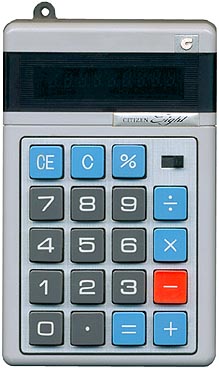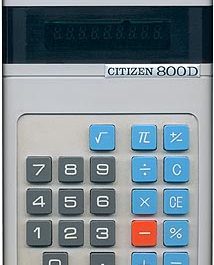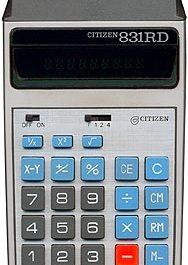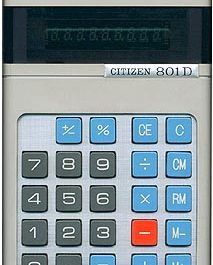
The Citizen Eight calculator, introduced in 1976, is a fascinating piece of technological history from the era when electronic calculators were becoming increasingly compact and affordable. This palm-sized device, measuring 64mm x 100mm x 22mm and weighing just 84 grams without batteries, epitomizes the drive towards miniaturization in consumer electronics during the mid-1970s.
Manufactured by Citizen Business Machines Inc. in Japan, the Citizen Eight features a sleek two-piece case design in dark and light grey plastic. The calculator’s aesthetics are further enhanced by a brushed aluminum keyboard surround and a metallic label bearing the brand and model name. A distinctive green plastic display filter wraps around the sides, adding a touch of visual interest to the device’s appearance.
At the heart of the Citizen Eight lies an 8-digit green vacuum fluorescent display (VFD), complemented by a ninth digit for negative and error indication. This display technology, typical of the era, offered excellent visibility and low power consumption compared to earlier LED displays. The calculator is powered by three AAA batteries, providing 4.5V DC and consuming a mere 0.15W of power.

The Citizen Eight’s compact form factor does not compromise on functionality. It offers standard four-function arithmetic capabilities along with percentage calculations, catering to the everyday computational needs of its users. The calculator’s logic is driven by a Toshiba T3332 51 microprocessor, a 28-pin DIL chip that represents the rapidly advancing integrated circuit technology of the time.
Internally, the Citizen Eight showcases the intricate engineering required to create such a compact device. The main board, designated as 80-Ea, is remarkably small and is connected to the keyboard assembly (GK-195-1) via 12 short, strong wires. This design approach allowed for efficient use of space while maintaining reliability.
The calculator’s construction permits easy access for maintenance or repair. A single screw at the rear allows the case to be opened, with the front or back hinging from the bottom edge. This user-serviceable design was common in electronic devices of the era, contrasting sharply with the sealed, disposable nature of many modern gadgets.

Despite its innovative design, the Citizen Eight’s computational logic exhibits several quirks and limitations common to calculators of its time:
- The CE key cancels an entry, while the C key clears the entire calculator.
- Input overflow is suppressed, with the ninth digit being ignored.
- Automatic constant function is available only for multiplication and division.
- Negative numbers are indicated by a “-” sign in the far-left (ninth) digit.
- Overflow results are displayed with an “E” in the far-left digit and are not recoverable.
- Division by zero shows zero with an “E” in the far-left digit, also not recoverable.
- The percentage key simply divides by 100 repeatedly.
- It suffers from the pseudo fixed decimal bug, where certain inputs can lock the display into a fixed decimal format.
- The calculator exhibits the divide to minus zero bug, where repeated division can result in a negative zero display.
The Citizen Eight calculator was a significant step in the evolution of portable computing devices. Its compact design, coupled with standard calculation capabilities, made it an attractive option for consumers seeking a handbag-friendly calculator. However, its computational quirks and limitations also highlight the ongoing challenges in calculator design during this period. The Citizen Eight serves as a tangible reminder of the rapid progress in electronic miniaturization and the compromises often required in early consumer electronics.


